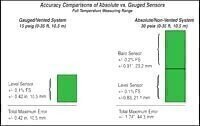Water/Wastewater
Using Absolute Vs. Gauged Water Level Sensors
Jun 18 2008
The back of an absolute (non-vented) pressure sensor is sealed fromthe atmosphere, so the front of this sensor responds to both atmospheric pressure as well as the pressure head of water above the sensor. Itsmeasurement incorporates pressure fromthe atmosphere and is
quantified in mbar a (millibar “absoluteâ€) relative to zero pressure. Absolute sensors must be compensated for atmospheric pressure to delivermeaningful data.
The vent tube in a gauged (vented) sensor allows atmospheric pressure to be applied to the back of the pressure sensor – canceling out the effect of external atmospheric pressure fluctuations. Measurements are in mbar g (millibar “gaugedâ€) relative to atmospheric pressure. Gauged sensors must be deployed on vented cables with desiccant.
Which Sensor Should I Use?
Barometric pressure applies a direct stress on open wells and surface water. Barometric effects can change dramatically from location to location as a result of topography andmicrometeorological changes. In confined aquifers, these atmospheric pressure fluctuations will cause dramatic water level changes if the monitoring well is open to the atmosphere. While an absolute sensor will work in this application, documentation of barometric data for the duration of the test will be needed in order to correct absolute measurements for barometric pressure effects. Such post-test processing can introduce cumulative error of two to three times the stated accuracy specification of the pressure sensor alone (see Figure 1).
Barometric effects typically do not have as great an impact on water levels of unconfined aquifers or surface water. However, when testing ground water or surface water in such an application, barometric fluctuations cause a direct effect on any one absolute sensor, requiring the sensor to be corrected with barometric data to obtain the most accurate water level elevations.
Applications
Absolute sensors will work for all applications – provided that a barometric record is kept for applications requiring correction for
barometric fluxes. Post processing of absolute sensor data can result in cumulative error greater than the sensor’s accuracy specification. A gauged sensor eliminates the effect of varying barometric pressure on themeasurement and the need for post-logging data compensation. In summary, a gauged sensor yields the most accurate water level data and eliminates the need to correct for atmospheric pressure influences. In-Situ® Inc. offers the most complete range of gauged and absolute water level instruments on the market today, please see www.in-situ.com for details.
Digital Edition
AET 28.2 April/May 2024
May 2024
Business News - Teledyne Marine expands with the acquisition of Valeport - Signal partners with gas analysis experts in Korea Air Monitoring - Continuous Fine Particulate Emission Monitor...
View all digital editions
Events
Jul 30 2024 Jakarta, Indonesia
China Energy Summit & Exhibition
Jul 31 2024 Beijing, China
2024 Beijing International Coal & Mining Exhibition
Aug 07 2024 Beijing, China
IWA World Water Congress & Exhibition
Aug 11 2024 Toronto, Canada
Aug 25 2024 Stockholm, Sweden and online









.jpg)








